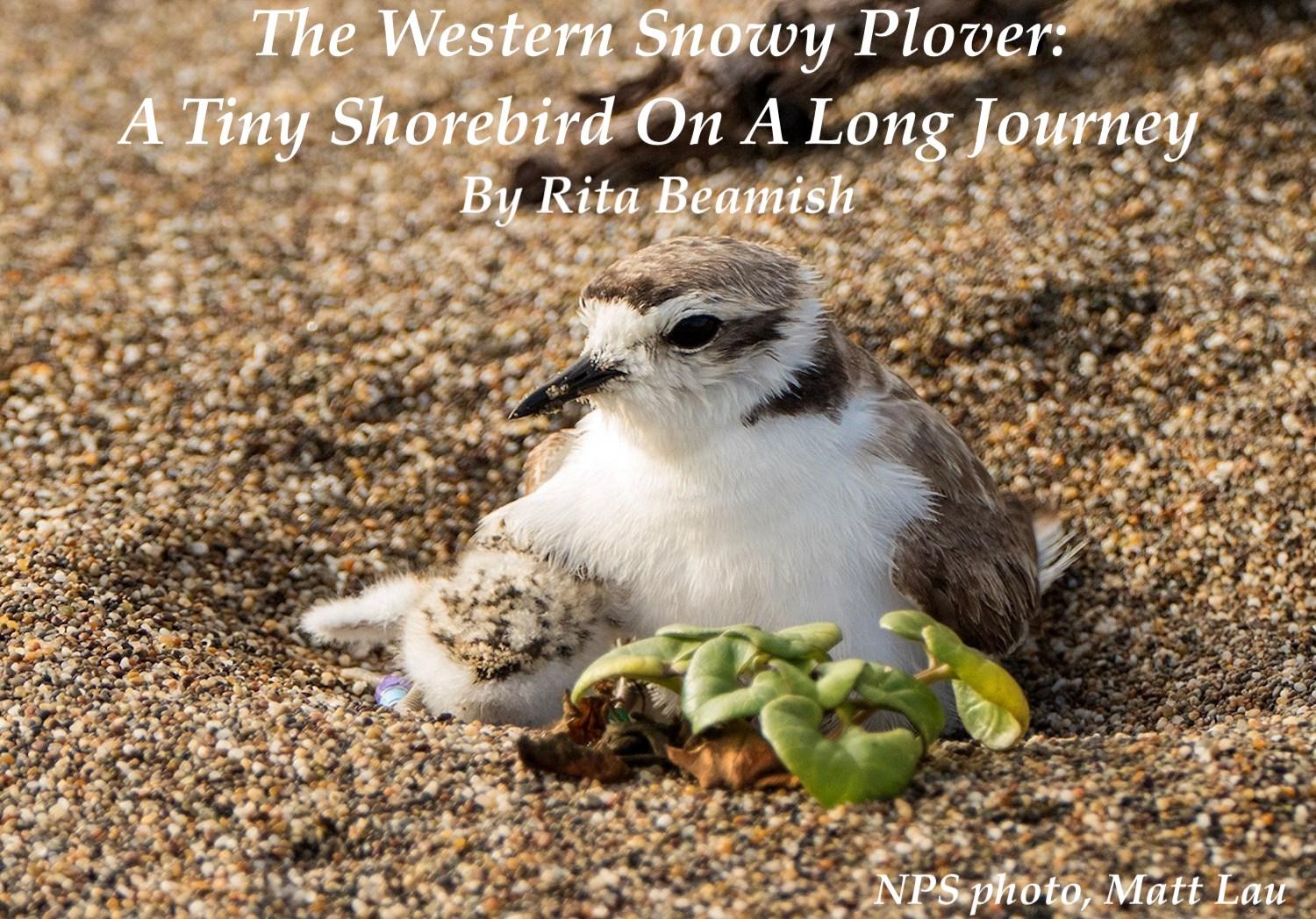
POINT REYES NATIONAL SEASHORE — Winter here was long, soggy and colder than usual as a stormy California freed itself from a brutal, multiyear drought. But springtime at long last emerged, and the king and queen again are sitting on their throne — or, specifically, their nest.
Amid the sand and sparse vegetation along a Point Reyes National Seashore beach, the royal couple, their white-and-sand-colored feathers blending flawlessly with the terrain, are reigning just like they always do when it’s time to mate and lay eggs.
“The king and queen, they both nest here every year,” and in fact they never leave Point Reyes’ 4-mile-long Limantour Beach, said National Park Service biologist Matt Lau. They take turns sitting on their nest, typically three eggs to a clutch, during the four-week incubation.
Their royal appellation? That was bestowed on them by the National Park Service team that works to ensure nobody disturbs the birds or their nests in this coastal habitat north of San Francisco because they are a threatened shorebird.
The king and queen are coastal Western snowy plovers, listed under the U.S. Endangered Species Act as a threatened species on the Pacific Coast from the state of Washington to the Mexico border. The 1993 listing cited loss of habitat due to human disturbance, development and invasive grasses, along with growing predator populations as the chief factors in the birds’ steep plunge, numerically, during the 20th century. The species also is found in interior areas of Oregon, California, Nevada, and in other Western states and Baja California. Only the U.S. West Coast populations are listed as threatened.
By the late 1970s, the snowy plovers were already absent from approximately 70 percent of their historical breeding locations, U.S. Fish & Wildlife scientists say.
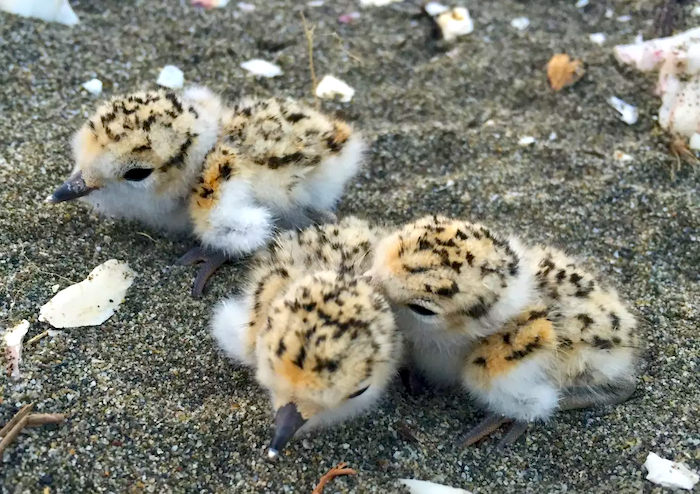
A clutch of snowy plover chicks/USFWS file, Nora Papian
Their numbers were as low as 1,100 in 2000. But recovery efforts by state, federal, and nonprofit groups brought the West Coast population back to an estimated 2,200 birds two decades later. Under the Fish & Wildlife Service’s recovery plan, the birds have to number at least 3,000 for 10 years, with each of six coastal recovery regions meeting individual goals as well, in order to be delisted.
Point Reyes accounted for 39 of the snowy plovers as of last year’s count, with 34 nests. (Females typically nest more than once per season.) Just one decade earlier, the park’s count was nine birds. Point Reyes has made progress toward on track to meet its recovery goal of 64, Lau said, but challenges remain.
Concern for the birds has broader implications because Western snowy plovers are an indicator species that signals the health of the coastal ecosystem; their habitat degradation indicates a broader ecosystem decline.
“It’s hard to have an intact beach ecosystem and not have snowy plovers,” said Kriss Neuman, principal ecologist in the Monterey Bay region for Point Blue Conservation Science, a nonprofit organization that initiated monitoring of the snowy plovers in 1995 and works on research and recovery efforts.
“Once you have native habitat and enough buffer from human disturbance, you will have snowy plovers. This has happened time and again” at coastal locales where dune restoration and habitat protection efforts, such as keeping out dogs, have occurred, Neuman said. “They are highly responsive to the state of the environment."
The Human Factor
“Dogs on leash!”
Lau’s voice carries across the sand, bouncing over the roar of surf. It reaches a woman whose three large dogs are cavorting in the sand not far from the water. She waves in acknowledgement and scurries to corral her rambunctious trio.
It’s not obvious where she entered Limantour Beach, but if she came from the main parking lot, she passed a sign saying dogs must be leashed in the area where hers were running free. Closer to the plover nests, in the opposite direction, dogs are not allowed at all.
The sensitive adult plovers each weigh less than about 2 ounces. The nearby presence of humans and dogs can be highly destructive.
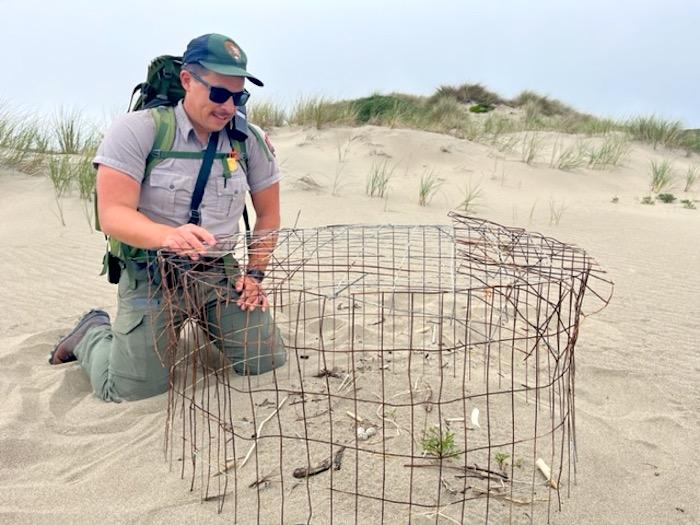
National Park Service biologist Matt Lau inspects an exclosure protecting a clutch of Western snowy plover eggs/Rita Beamish
“Beaches are so crowded during the summer months,” said Lau, and many people ignore the dog prohibitions. Park Service precautions include “symbolic fencing” — lengths of cord strung between thin poles — and no-entry signs to dissuade people from straying up from the beach into nesting areas. Volunteer docents are on hand during busy season to spread the word about the sensitive habitat.
The Royals
Limantour Beach sees few plovers — maybe two or three nesting pairs a year — but the royal couple has lived and reliably nested together each year since 2018. The queen was born on the beach in 2017 and never left, said Lau.
On a gray day at the end of April, the ocean air is damp. The king, a tiny snowball of a body on stick legs, scurries back and forth at Limantour. He’s foraging on the flat, wet sand in the plover look-run-stop-look pattern to spot insects and other small munchies.
The queen is about 60 yards away, up in the sparsely vegetated dunes where her three speckled eggs sit exposed atop the sand, albeit camouflaged by their coloring in a nest consisting of a few twigs and pebbles. If not exactly seeking contact, the queen is at least “very tolerant of humans,” seemingly more so than her partner, according to Lau.
But on this day, she notices the approach of Lau and a reporter and begins skittering across the sand, zigging and zagging and flapping — anything to divert attention from her nest.
Her Majesty, however, needn’t worry. Surrounding her nest is an “exclosure,” a wire cage-like covering with openings big enough for the adult birds to get in and out, but too small for hungry predators to enter.
The exclosures have been working, park officials say. Park staff install them around all the plover nests they find and say the practice is a big factor in egg protection.
Enclosing With Exclosures
Point Reyes data show that from 2016 to 2021, 70-90 percent of eggs in exclosure-surrounded nests hatched successfully. Where nests did not have the wire-mesh protection and thus were vulnerable to predators, “no more than 20 percent” were successful, Lau’s research found.
The 2022 results: of 29 exclosure-protected nests, 19 hatched at least one egg. Overall, Point Reyes last year also recorded its highest fledge rate — the percentage of chicks that survived — since 2012, at 54 percent, and highest number of fledged chicks, 28, since 1997.
No nest failures were attributed to the main threat — predation by common ravens — and hatch success was observed even for three of the five nests that were not exclosed.
“Without exclosures, nest success, especially during the first half of the season, would be abysmal due to common ravens and other predators,” which include small mammals, Lau said.
Exclosures are particularly crucial as the only predator control at Point Reyes, unlike other locations along the West Coast, where an assortment of methods, including trapping, hazing, and lethal means, are employed.
A 2020 nest of Western snowy plovers at Point Reyes National Seashore protected by an exclosure/NPS video, Matt Lau.
An Oregon study, meanwhile, found that while protecting eggs, exclosures can pose a risk for adult birds when they go out foraging. Predators can “just pick them off,” by keying in on exclosures and associating them with the tiny birds, said Neuman.
Aware of that risk, Point Reyes staff check on plover nests every 1-3 days, said Lau. The park also switched from 4-foot-tall round exclosures to a smaller model to reduce visibility to predators and people, and decrease the distance for plovers from nest to foraging grounds. The exclosures are left in place even beyond nesting season, Lau said, in hopes of dissuading predators from associating the cages with prey.
“As far as we know, we do not have evidence that we lost an adult to a predator,” said Lau. But the park is worried about at least one exclosure nest near a beach parking lot that appears to be abandoned, perhaps because of predator activity. Biologists have installed a camera to monitor a nearby nest for predator activity.
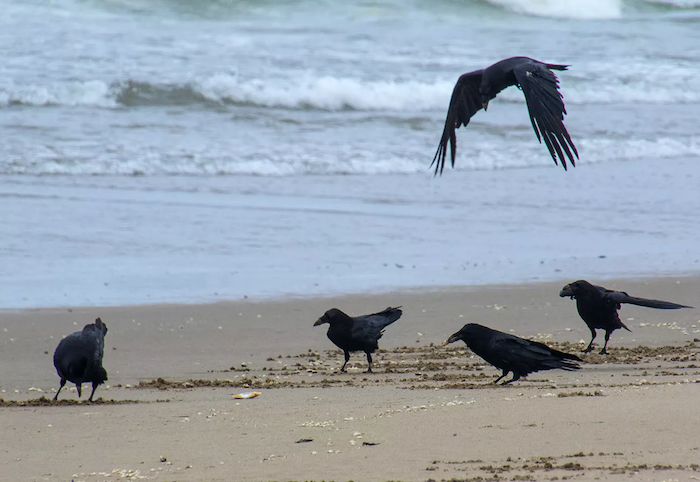
Common ravens are a threat to the Western snowy plovers/NPS
“Despite the risk, in Point Reyes it does appear that exclosure use far outweighs the potential negative effects,” Lau said. “But we do need to continue monitoring nest exclosures frequently to ensure that the adult plovers are safe.”
U.S. Fish & Wildlife officials conclude that, “Nest exclosures have been and continue to be a valuable tool in recovering plovers by reducing nest predation,” according to Susan Sawyer, a public affairs officer for the agency. Different designs have benefits and risks, the agency notes, and “careful consideration” is needed “to ensure that nest exclosures are appropriate tools at a given location to achieve management objectives.”
Warming Impacts
Climate change poses growing risk for snowy plovers, researchers say, particularly from sea level rise that will diminish beachside nesting habitat. But an encroaching sea is not all that spells trouble. Invasive European beach grass already is moving into the open terrain the birds favor at Point Reyes.
Rising temperatures also will favor predators that threaten the plovers, a Point Blue Conservation Science study said. It noted that overall nest success improved when temperatures were lower ahead of the March-September breeding season. But only nests not protected by exclosures failed in warmer temperatures. Exclosure nests were fine. That indicated the predators flourished in rising temperatures and were able to increase attacks on unprotected nests.
On the other hand, warmer temperatures help chick survival, nurturing them in the two weeks after hatching when they are most vulnerable to cold, the researchers said.
Point Reyes biologists say adaptive management strategies will be key for saving the tiny birds as the environment changes. The national seashore has traditionally banded chicks with color-coded leg bands to keep track of their survival and travels, but more recently has also been banding adults to better monitor population trends and habitat locations.
On The Right Track?
“The good news is the population has been steadily increasing since the early 2000s, because of the range-wide management efforts and monitoring efforts by federal and state agencies,” in collaboration with nonprofit and research organizations that shoulder a lot of plover recovery work, said Lau.
Still, “it’s a slow upward trend,” the biologist said. “For five years it’s stabilized. It hasn’t quite grown as much as we would like it to.”
“We’ve sort of stalled,” Neuman concurred. The Washington and Oregon recovery region, with fewer birds than California, has met its numeric recovery goals. California has not. Point Blue Conservation Science is working on a project with California’s state parks officials to understand where the plovers are doing well and why some habitats are less successful. The project follows the organization’s earlier study of how plovers will be affected by climate change and rising sea levels.
The threat from ravens is significant and growing as they feed on trash and agriculture and ranching products near plover habitat, according to a 2021 study by a group of scientists, including Lau and Neuman, from U.S. Fish & Wildlife, California state parks, and other agencies and organizations. The researchers concluded that more mitigation tools must be used, including lethal and nonlethal chemical and trapping methods.
U.S. Fish & Wildlife notes progress toward recovery but also says, “Threats to the plovers including habitat loss and degradation, severe weather and climate change, expanding predator populations and human recreation in plover breeding areas continue to limit the overall success of plovers throughout their range.”
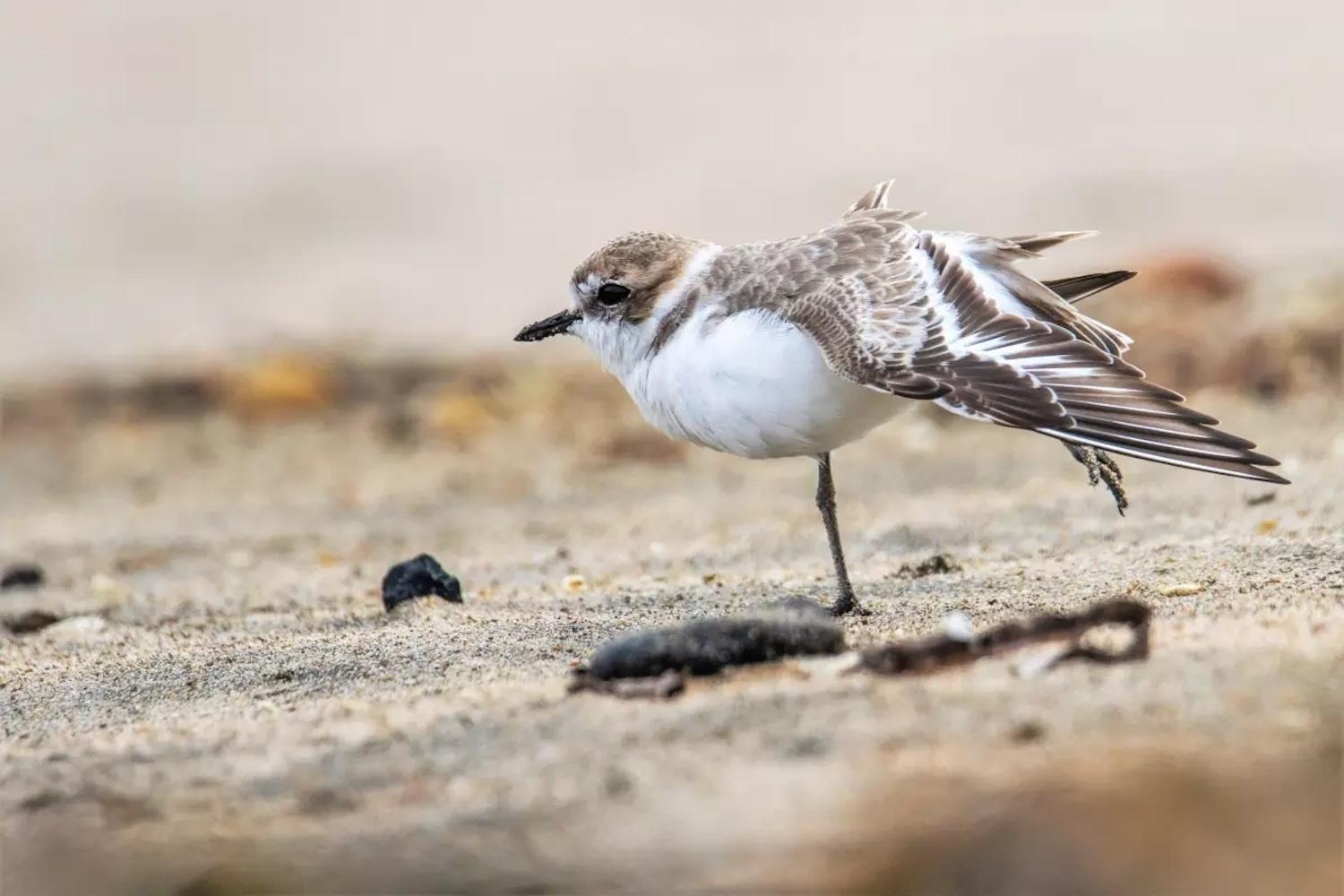
A Western snowy plover streteching its legs/USFWS, Timothy Ludwick
At Point Reyes, biologists were encouraged by last year’s nesting and fledging and say this season also is off to a good start.
The plovers began nesting a few weeks later than usual, presumably waiting out the unseasonably late wet and cold weather, and the park has found 20 nests so far: 14 remain active, and two others have already hatched. Four failed: two that did not yet have exclosures placed and suffered raven predation, another that was engulfed by tide, and one exclosure nest that was abandoned by the adult female for unknown reasons.
The king and queen of Limantour are doing fine on their nest, Lau reports, with Tuesday projected as the big day for hatching.


Comments
So glad to read this story and know that park efforts are paying off with reproductive success.
According to NPS, "Common ravens are the primary predators of nests and hatchling snowy plovers at Point Reyes National Seashore." The ranches in Point Reyes attract unnatural concentrations of ravens. I am glad the article mentions that. What is not mentioned is that NPS is currently being sued over the wildly unpopular and unscientific plan to continue ranching in Point Reyes. It's well past time for those ranches to clear out and allow Point Reyes to be park instead of a feedlot.